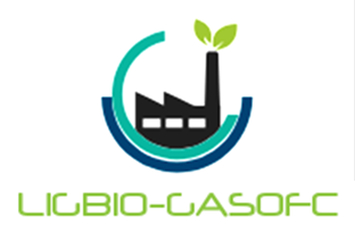LIGBIO-GASOFC focuses on the development and evaluation of novel materials (catalysts, electrodes, inks), devices (solid oxide fuel cells, SOFCs) and processes for the efficient co-current energy conversion of Greek Lignite and/or agricultural residues to electrical/thermal power in integrated gasification/SOFC and Direct Carbon Fuel Cell (DCFC) processes at high efficiencies and low environmental footprint, in line with the Thematic Priority 7.7/Sub-priority 7.7.4 of the call.
The innovative approach at LIGBIO-GASOFC involves the gasification of pristine and optimal treated solid fuels/chars both externally and in-situ the SOFC, through a catalytically-aided process. In particular, the project will initially examine the efficiency of an integrated external gasification-SOFC system (GASOFC), where emphasis will be placed on the optimal conjunction of the two devices and on the maximization of syngas production efficiency (> 90%) and its subsequent feed in a SOFC. In contrary to the external GASOFC configuration, the advantage of the internal catalytic gasification Direct Carbon Fuel Cell (DCFC) set up, using CO2/H2O exhaust gases as gasification agents, lies in the direct electro-oxidation of the in situ generated CO/H2 at the DCFC anode, effectively bypassing the diffusion and kinetic limitations resulting by the limited contact between the solid fuel and the electrode/electrolyte interface. The project will also focus on further optimization, scale-up and benchmarking of GASOFC and DCFC proposed technologies. Particular attention will be paid on the development of active and stable electrodes/catalysts, which will be used both for the catalytic gasification of solid fuels and for the electro-oxidation of H2/CO and Lignite/Biomass in GASOFC and DCFC processes, respectively. Furthermore, two advanced deposition techniques namely, 3D inkjet-printing and liquid thermal spraying (LPS) will be employed to fabricate the SOFC/DCFC single-cells (150 mW/cm2) and stacks (0.2 kWel). The implementation of the LPS technique provides the capabilities of employing nano-materials and avoiding unnecessary sintering stages. At the same time, 3D printing is the most cost-effective and energy-efficient deposition technology as it can easily be integrated into industrial production lines. To this direction, research efforts will focus on the development of nano-dispersed materials to prepare suitable inks for 3D-printing. Experiments will then be carried out to evaluate the GASOFC and DCFC processes at lab- and semi-pilot scales. Within the progress of project’s realization, a feasibility study of the proposed technologies will be elaborated by additionally assessing their environmental footprint. Finally, the project’s industrial partners, together with the research organizations, will elaborate the dissemination and exploitation plan of the project results.
The implementation of LIGBIO-GASOFC interdisciplinary research will be carried out by a complementary consortium enrolling 2 academic participants (UoWM, TUC) and one research center (FORTH), comprising the research pillar, and 2 companies (industry pillar) being active in the development of materials (EVETAM) and energy production sector (PPC-KDEP), bringing the full range of expertise and infrastructure/instrumentation required for the successful project implementation as well as for the optimum exploitation of project results.

